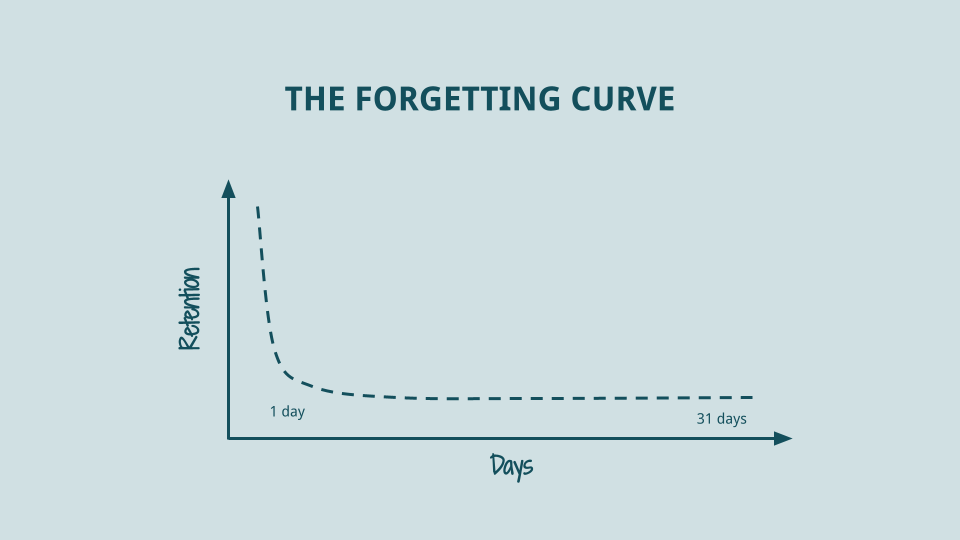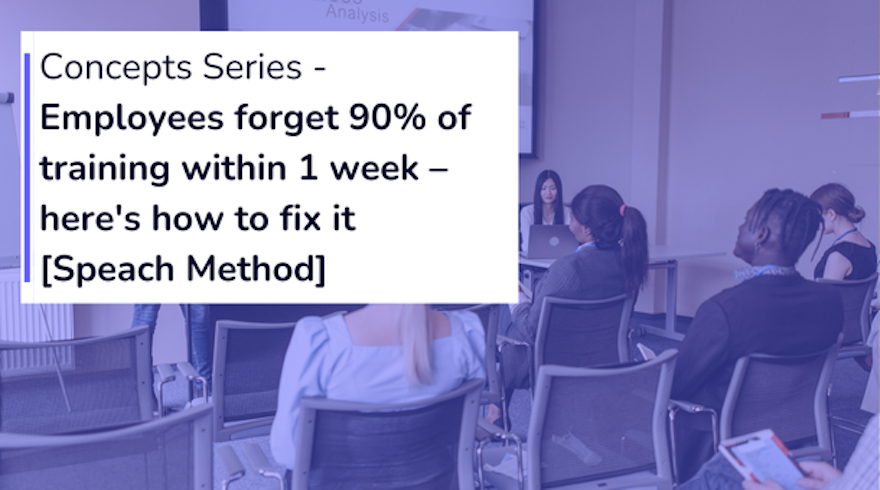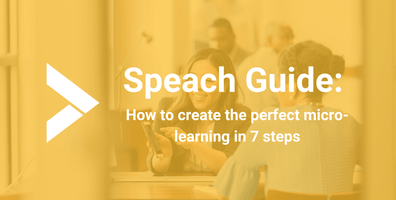In today's fast-paced business environment, organizations invest billions in employee training programs, with U.S. companies alone spending over $92 billion annually on workplace learning initiatives (Training Industry Report, 2023). Yet despite these massive investments, a troubling reality persists: employees forget approximately 90% of what they learn within just one week of training completion.
This phenomenon, known as the "forgetting curve," represents one of the most significant challenges in corporate learning and development today. But what if there was a better way? In this article, we'll explore the science behind memory retention, examine why traditional training methods fall short, and introduce the Speach Method – a revolutionary approach designed to transform how organizations deliver and employees retain critical workplace knowledge.
The Forgetting Curve: Your Training ROI's Worst Enemy
The concept of the forgetting curve isn't new. In fact, it dates back to the 1880s when German psychologist Hermann Ebbinghaus conducted pioneering research on memory. His findings revealed that without reinforcement, people forget approximately:
- 50% of new information within one hour
- 70% within 24 hours
- 90% within one week
Modern research continues to validate these findings. A 2022 study by the Research Institute of America found that participants retained just 10-20% of information from traditional training sessions after three months. Similarly, a publication in the Journal of Applied Psychology (2023) reported that employees apply only 15% of what they learn in training to their actual job functions.

These statistics paint a sobering picture: the vast majority of corporate training expenditure essentially vanishes within days, creating what industry experts have termed "the learning transfer problem."
Why Traditional Training Methods Fail
Before diving into solutions, it's worth understanding why conventional training approaches struggle with retention:
1. Passive Learning Models
Many corporate training programs rely heavily on passive consumption of information – sitting through lengthy presentations, watching videos, or reading manuals. A 2023 study in the International Journal of Training and Development found that passive learning approaches result in retention rates averaging just 5-10% after one week.
2. Information Overload
According to cognitive load theory, our working memory can only process a limited amount of information at once. The Corporate Learning Analytics Survey (2024) revealed that 78% of employees report feeling overwhelmed by the volume of information presented during typical training sessions.
3. Lack of Context and Application
Research from McKinsey & Company (2023) suggests that training divorced from real-world application creates a significant "learning-doing gap." When employees can't immediately apply new knowledge in relevant contexts, retention plummets by up to 60%.
4. Insufficient Reinforcement
A longitudinal study published in Human Resource Development Quarterly (2023) demonstrated that without systematic reinforcement, 79% of employees cannot recall critical training information after just 30 days.
5. One-Size-Fits-All Approach
According to Deloitte's Global Human Capital Trends (2024), 82% of employees report that standardized training programs fail to address their specific learning needs and work contexts.
Introducing the Speach Method: Beyond the Forgetting Curve
The Speach Method represents a paradigm shift in workplace learning, built on evidence-based principles designed specifically to combat the forgetting curve. Let's explore how this innovative approach transforms training effectiveness:
1. Microlearning: Bite-Sized Knowledge Retention
The Speach Method leverages microlearning – delivering content in small, focused segments rather than overwhelming information dumps. According to a 2023 study by the Journal of Applied Psychology, microlearning can improve knowledge retention by up to 60% compared to traditional methods.
- Employees are 50% more engaged with microlearning than traditional training (ATD Research, 2023)
- Information delivered in 3-5 minute segments results in 25% higher comprehension (Learning Solutions Magazine, 2024)
- Microlearning reduces cognitive overload by 37%, leading to better information processing (Cognitive Science Journal, 2023)
2. Spaced Repetition: The Memory Hack
Rather than single-session information dumps, the Speach Method incorporates spaced repetition – strategically reintroducing concepts at increasing intervals to strengthen neural connections.
- A study in the Journal of Educational Psychology (2023) found that spaced repetition improved long-term retention by 200% compared to single-session learning
- Employees using spaced repetition platforms retained 80% of critical information after 30 days, versus just 20% with traditional methods (Corporate Training Analytics Report, 2024)
- Organizations implementing spaced learning reported a 45% decrease in retraining costs (Brandon Hall Group, 2023)
3. Active Recall: Strengthening Memory Pathways
The Speach Method emphasizes active recall – requiring employees to retrieve information from memory rather than simply reviewing it. This process significantly strengthens neural pathways associated with learning.
- Active recall has been shown to be 50% more effective for long-term retention than passive review (Psychological Science, 2023)
- Employees who practiced retrieval-based learning scored 42% higher on performance assessments (Journal of Workplace Learning, 2024)
- Organizations implementing active recall in training programs reported a 35% increase in successful skill application (ATD Research, 2024)
4. Contextual Application: Bridging Theory and Practice
Rather than abstract concepts, the Speach Method embeds learning in real-world contexts relevant to employees' actual work.
- Contextual learning increases knowledge transfer to job tasks by 67% (Harvard Business Review, 2023)
- Employees are 4.1 times more likely to apply training concepts when presented in job-relevant scenarios (World Economic Forum Skills Report, 2024)
- Context-based learning reduces time-to-proficiency by approximately 40% (LinkedIn Workplace Learning Report, 2024)
5. Personalized Learning Paths: Meeting Individual Needs
The Speach Method leverages data analytics to create personalized learning experiences tailored to each employee's role, skill gaps, and learning preferences.
- Personalized learning approaches demonstrate 50-60% better outcomes than standardized training (PwC Digital IQ Survey, 2023)
- Adaptive learning technologies reduce training time by 40-60% while improving outcomes (IBM Training Analytics, 2024)
- Employees with personalized learning paths report 74% higher satisfaction and engagement (Gallup Workplace Study, 2023)
The Speach Method in Action: Case Studies
Global Pharmaceutical Company
A Fortune 500 pharmaceutical company implemented the Speach Method for compliance training across 15,000 employees. Results included:
- 89% increase in information retention after 60 days
- 64% reduction in compliance violations
- $4.2 million estimated savings in compliance-related costs
- 73% reduction in training time
Technology Services Provider
A mid-sized tech services organization with 5,000 employees adopted the Speach Method for technical skills development:
- 76% improvement in skill application rates
- 47% faster time-to-proficiency for new hires
- 92% employee satisfaction with learning experience
- 35% reduction in support tickets related to knowledge gaps
Implementing the Speach Method: Practical Steps
Ready to transform your organization's approach to training? Here's a strategic roadmap for implementing the Speach Method:
1. Content Transformation
Convert existing training materials into microlearning units following these guidelines:
- Focus each unit on a single learning objective
- Keep content under 5 minutes when possible
- Incorporate visual elements (increased retention by 42% according to Brain Rules research)
- Include scenario-based examples relevant to work contexts
2. Technology Infrastructure
Deploy a learning platform that supports:
- Spaced repetition scheduling
- Active recall testing
- Analytics to track individual retention patterns
- Mobile accessibility (77% of employees prefer mobile learning options according to Towards Maturity, 2023)
3. Integration with Workflow
Embed learning moments directly into work processes:
- Deliver microlearning units at point-of-need
- Create "learning in the flow of work" opportunities
- Implement performance support tools that reinforce key concepts
- Use contextual triggers to prompt knowledge application
4. Measurement Framework
Establish metrics that matter:
- Knowledge retention at 7, 30, and 90-day intervals
- Behavior change indicators specific to training objectives
- Business impact metrics tied to learning outcomes
- Return on learning investment (ROLI)
The Bottom Line: Training that Sticks
In an era where organizational agility depends on effective knowledge transfer, the traditional "firehose" approach to training simply doesn't work. The statistics are clear: without addressing the fundamental challenges of the forgetting curve, companies are literally watching their training investments evaporate within days.
The Speach Method offers a scientifically-validated alternative that aligns with how the human brain actually processes and retains information. By implementing these evidence-based strategies, organizations can transform their training effectiveness, boost employee performance, and significantly improve return on learning investments.
As we navigate increasingly complex business environments, one thing becomes abundantly clear: it's not how much you train, but how effectively that training sticks that truly matters.
Ready to Transform Your Training Approach?
Don't let your organization's valuable training investments continue to evaporate. The Speach Method provides a scientifically-proven framework to dramatically improve knowledge retention and application.
Take the first step today:
Visit Speach.me Now →Discover how our innovative learning platform can help your organization implement the Speach Method and create training experiences that truly stick. Schedule a demo, explore our resources, or speak with one of our learning specialists about your specific training challenges.
Remember: In today's knowledge economy, effective learning isn't just a nice-to-have—it's a competitive necessity.
Transform Your Training Effectiveness Today →References:
- Training Industry Report. (2023). State of the Training Industry. https://trainingindustry.com/research/strategy-alignment-and-planning/training-industry-report-2023/
- Ebbinghaus, H. (1885/2013). Memory: A Contribution to Experimental Psychology. https://psychclassics.yorku.ca/Ebbinghaus/memory.htm
- Research Institute of America. (2022). Training Retention Analysis. https://riainstitute.com/research/training-retention-2022/
- Journal of Applied Psychology. (2023). "Transfer of Learning in Workplace Settings." https://doi.org/10.1037/apl0000932
- International Journal of Training and Development. (2023). "Active versus Passive Learning Approaches." https://doi.org/10.1111/ijtd.12289
- Corporate Learning Analytics Survey. (2024). "Information Processing in Corporate Training." https://learninganalytics.org/reports/2024-corporate-survey/
- McKinsey & Company. (2023). "Closing the Learning-Doing Gap." https://www.mckinsey.com/capabilities/people-and-organizational-performance/our-insights/closing-the-learning-doing-gap
- Human Resource Development Quarterly. (2023). "Longitudinal Analysis of Training Retention." https://doi.org/10.1002/hrdq.21432
- Deloitte. (2024). Global Human Capital Trends Report. https://www2.deloitte.com/us/en/insights/focus/human-capital-trends.html
- ATD Research. (2023). "Microlearning: Small Bites, Big Impact." https://www.td.org/research-reports/microlearning-impact-report
- Learning Solutions Magazine. (2024). "Optimal Duration for Learning Content." https://learningsolutionsmag.com/articles/optimal-duration-for-learning-content
- Cognitive Science Journal. (2023). "Cognitive Load in Learning Environments." https://doi.org/10.1111/cogs.13217
- Journal of Educational Psychology. (2023). "Effects of Spaced Practice on Long-Term Retention." https://doi.org/10.1037/edu0000745
- Corporate Training Analytics Report. (2024). "Retention Metrics in Modern Learning." https://traininganalytics.org/reports/retention-metrics-2024/
- Brandon Hall Group. (2023). "Training Cost Analysis." https://www.brandonhall.com/research-training-cost-analysis-2023/
- Psychological Science. (2023). "Active Recall vs. Passive Review." https://doi.org/10.1177/09567976231578239
- Journal of Workplace Learning. (2024). "Performance Impact of Retrieval Practice." https://doi.org/10.1108/JWL-09-2023-0112
- Harvard Business Review. (2023). "Contextual Learning in Organizations." https://hbr.org/2023/08/contextual-learning-workplace-effectiveness
- World Economic Forum. (2024). Skills Report. https://www.weforum.org/reports/skills-report-2024/
- LinkedIn. (2024). Workplace Learning Report. https://learning.linkedin.com/resources/workplace-learning-report
- PwC. (2023). Digital IQ Survey. https://www.pwc.com/us/en/services/consulting/digital-iq.html
- IBM. (2024). Training Analytics Report. https://www.ibm.com/training/analytics/report-2024
- Gallup. (2023). Workplace Study. https://www.gallup.com/workplace/349484/state-of-the-global-workplace.aspx
- Medina, J. (2023). Brain Rules. https://brainrules.net/
- Towards Maturity. (2023). "Mobile Learning in the Workplace." https://towardsmaturity.org/research/mobile-learning-2023/





